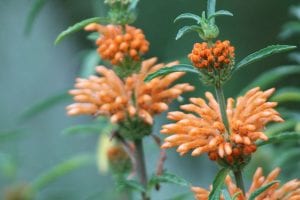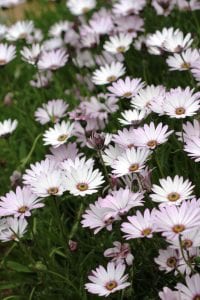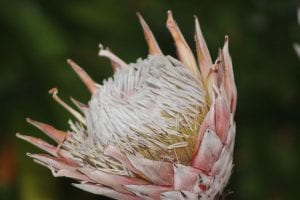Plantings from the Mediterranean Climate Region of the South West tip of South Africa are grown to show extreme adaptation to a seasonally dry environment and illustrate the rich diversity of plant biodiversity found in this region. Three biomes are on display: fynbos, renosterveld and succulent karoo biomes.

The first, the Fynbos biome, is characterised by plants with small hard leaves, well adapted to conserving water. The translation of the Afrikaans word fynbos literally means fine bush, which can bee seen in many of the plants grown. Cape reeds or Restios in the Restionaceae with their hard stems and absence of leaves dominate the display with plantings of Chondropetalum tectorum, Elegia capensis and Restio quadratus. Cape heaths, Ericaceae with small leaves and brightly coloured flowers represent some 480 species of the 650 known species of Erica. Erica cerinthoides, a red flowered bird pollinated species is grown and usually overwinters with other Erica species planted out for the summer. A larger collection of cape heaths can be seen in the warm temperate zone of the glasshouse.
The protea family, the Proteacea is extremely varied and is represented by the plants; Leucadendron argenteum, Mimetes cucullatus, Leucospermum cordifolium and Protea. Within the genus Protea, Protea cynaroides has large leathery leaves held so one edge of each leaf points towards the mid day sun. This genetic trait ensures that the broad leaves do not overheat during the day. Other fynbos species include: Gnidia squarrosa, Bobartia robusta and Helichrysum cymosum. Bulbous plants occur in huge diversity within the Mediterranean Climate Region of the South West tip of South Africa many going dormant during the long hot dry summer months. Some bulbous or ‘geophytic’ plants including: Tulbaghia violacea, Amaryllis belladonna, Watsonia marginata and Chasmanthe bicolor are grown, with much larger collections in the warm and cool zones of the glasshouse.

Large boulders of hard large-quartz and iron rich sandstones between ~200-250million years of age have been landscaped into the fynbos display mirroring the geology and appearance of the mountains of the Western Cape. These are slow to weather and have given rise to very nutrient poor soils commonly supporting fynbos communities. These poor, organic rich sandy soils have been replicated to cultivate the fynbos biome.
The renosterveld biome is characterised by the dominance of evergreen daisy family Asteraceae, pea family Fabaceae, coco family Sterculiaceae and daphne family Thymelaeaceae. Here we find plants of Eriocephalus africanus, Helichrysum teretifolium, Hermannia pinnata and Passerina rigida, all with small leaves, some with silver hairs to reflect heat and reduce water loss. Leonotis ocymifolia flowers in autumn and the geophyte Asparagus retrofractus is grown, illustrating both heavily reduced leaves and fleshy storage roots.
Sandstone boulders rich in iron have been landscaped into the display together with an iron rich silty soil. The higher nutrient levels from these soils give rapid plant growth.
The succulent karoo biome is primarily comprised of winter growing annuals in the Asteraceae and Brassicaceae and succulents in the Aizoaceae and Crassulaceae families.The area is characterised by dwarf succulent shrubs inter dispersed with annuals. Winter growing annuals, which flower during summer are sown each spring and augmented by succulents plunged into the display during the summer months.
All three of the biomes on display nestle against a west facing wall creating sheltered conditions for the cultivation, (some with winter protection) of plants from this region.

